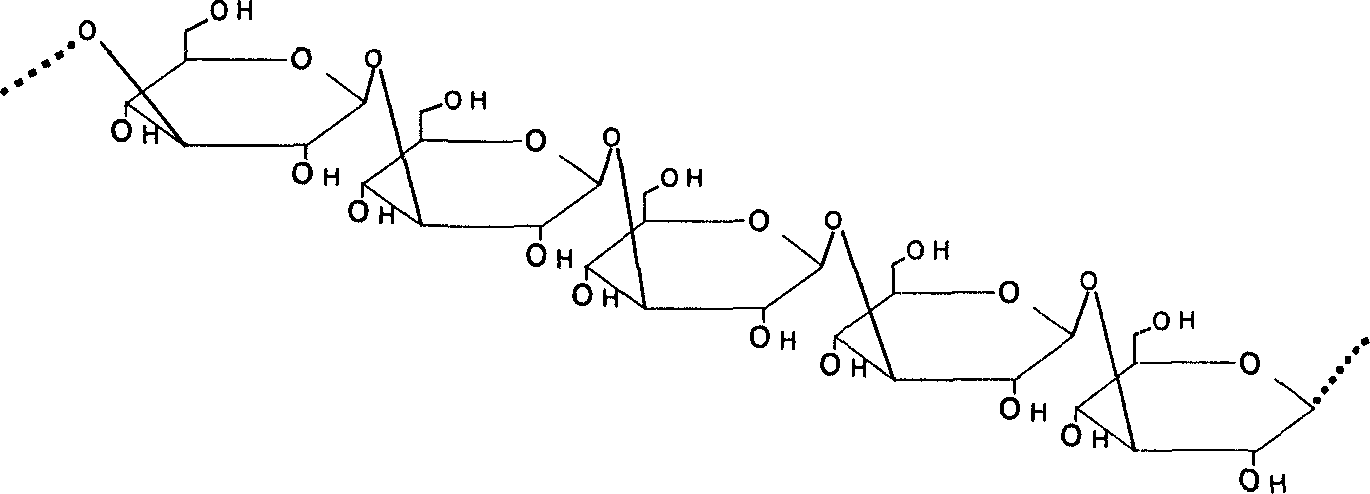Extracting process for microbiological polysaccharide-hot gel
A technology of microbial polysaccharide and extraction process, applied in the field of bioengineering, can solve problems such as impracticality, and achieve the effect of improving characteristics and good gelation.
- Summary
- Abstract
- Description
- Claims
- Application Information
AI Technical Summary
Problems solved by technology
Method used
Image
Examples
Embodiment 1
[0012] Embodiment 1. Preparation of thermogel fermented liquid
[0013] The strain Alcaligenes faecalis (Alcaligenes faecalis) WX-C12 was preserved and provided by the Biochemical Engineering Laboratory of the School of Bioengineering, Jiangnan University.
[0014] Fermentation medium (g / L) glucose 50, yeast extract 2, NH 4 Cl 3.6, KH 2 PO 4 2. MgSO 4 ·7H 2 O 0.5, inorganic salt concentrated solution 10mL, pH 7.0 (wherein inorganic salt concentrated solution: FeCl 3 1g, NaCl 1g, CaCl 2 1g, MnCl 2 1 g, 1 L deionized water).
[0015] Utilize 9L fermentation medium, adopt two-stage method (different pH values are controlled during bacterial cell growth and rubber production stage) to carry out fermentation on 15L Biostat C10-3 mechanical stirring tank, the inoculum size is 5%, the stirring speed of the fermenter is 500rpm, and the ventilation volume is 13.5L / min, gauge pressure 0.05MPa, fermentation temperature 30°C. The concentration of NaOH solution to adjust the ...
Embodiment 2
[0017] Embodiment 2. Preparation of thermogel fermented liquid
[0018] Bacterial strain and fermentation medium are with embodiment 1. Utilize 18L fermentation medium, inoculum amount 5%, adopt two-stage method (thalline growth and gel production stage control different pH value) to carry out fermentation on the 25L mechanical stirring tank, the stirring speed of fermentation tank is 300rpm, and ventilation rate is 27L / min, The gauge pressure is 0.05MPa, and the fermentation temperature is 30°C. The pH value is controlled at about 7.0 during the growth stage of the bacteria, and adjusted to about 5.6 after 21 hours until the end of fermentation.
[0019] The initial glucose concentration of the fermentation was 50g / L, and the glucose concentration in the fermentation broth dropped below 10g / L after 43 hours of fermentation, and 720g of glucose was added, and the glucose concentration in the fermentation broth dropped to below 10g / L again at 79h, and 720g of glucose was added...
Embodiment 3
[0020] Example 3. Extraction of Food Grade Thermogel
[0021] Take 2L of fermentation broth, centrifuge to discard the supernatant, dissolve the precipitates with solutions of different NaOH concentrations, remove the bacteria by centrifugation, neutralize the alkaline solution of the hot gel with hydrochloric acid, and wash the neutralized colloidal precipitate with deionized water 2 times, then dehydrated by pressing, then washed with a small amount of ethanol, dried, and crushed to obtain a food-grade thermal gel product.
[0022] The dried product was made into a 2% suspension, and after homogenization, it was heated in a water bath at 90°C for 10 minutes to form a gel, and the gel strength was measured by the Texture Analyzer of the Micro Stable System in the UK. The purity of thermogelling polysaccharide was determined by sulfuric acid-anthrone method. The properties of the thermal gel extracted under different alkali concentrations are shown in Table 1:
[0023] ...
PUM
 Login to View More
Login to View More Abstract
Description
Claims
Application Information
 Login to View More
Login to View More - R&D
- Intellectual Property
- Life Sciences
- Materials
- Tech Scout
- Unparalleled Data Quality
- Higher Quality Content
- 60% Fewer Hallucinations
Browse by: Latest US Patents, China's latest patents, Technical Efficacy Thesaurus, Application Domain, Technology Topic, Popular Technical Reports.
© 2025 PatSnap. All rights reserved.Legal|Privacy policy|Modern Slavery Act Transparency Statement|Sitemap|About US| Contact US: help@patsnap.com



